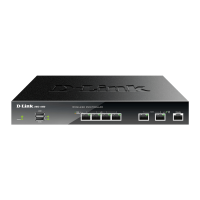D-Link DWC-1000 User Manual 312
Section 8 - Viewing Status and Statistics
Path: Status > Wireless Information > Access Point > De-Authentication Attacks
The AP De-Authentication Attack page contains information about rogue APs that the Cluster Controller has
attacked by using the de‐authentication attack feature. The wireless controller can protect against rogue APs
by sending de‐authentication messages to the rogue AP. The de‐authentication attack feature must be globally
enabled in order for the wireless system to do this function. Make sure that no legitimate APs are classied as
rogues before enabling the attack feature. This feature is disabled by default.
The wireless system can conduct the de‐authentication attack against 16 APs at the same time. The intent of this
attack is to serve as a temporary measure until the rogue AP is located and disabled.
The de‐authentication attack is not eective for all rogue types, and therefore is not used on every detected
rogue. The following rogues are not subjected to the attack:
• If the detected rogue is spoong the BSSID of the valid managed AP, the wireless system does not
attempt to use the attack because that attack may deny service to a legitimate AP and provide another
avenue for a hacker to attack the system.
• The de-authentication attack is not eective against Ad hoc networks because these networks do not
use authentication.
• The APs operating on channels outside of the country domain are not attacked because sending any
trac on illegal channels is against the law.
The wireless controller maintains a list of BSSIDs against which it is conducting a de‐authentication attack. The
controller sends the list of BSSIDs and channels on which the rogue APs are operating to every managed AP.
Field Description
MAC Address
Ethernet MAC address of the detected access point. This could be a physical
radio interface or VAP MAC.
SSID
The wireless name (Service Set Identier) of the network, which is broadcast
in the detected beacon frame.
Physical Mode The 802.11 mode used on the access point.
Channel Transmit channel of the access point.
Age
Time since this access point was last detected in an RF scan. Status entries for
this page are collected at a point in time and eventually age out. The age value
for each entry shows how long ago the wireless controller recorded the entry.
Status
Managed status of the access point. The valid values are:
• Managed = Neighbor access point is managed by the wireless system.
• Standalone = Access point is managed in standalone mode and
congured as a valid AP entry (local or RADIUS).
• Rogue = Access point is classied as a threat by one of the threat detection
algorithms.
• Unknown = Access point is detected in the network but is not classied
as a threat by the threat detection algorithms.
De-Authentication Attacks

